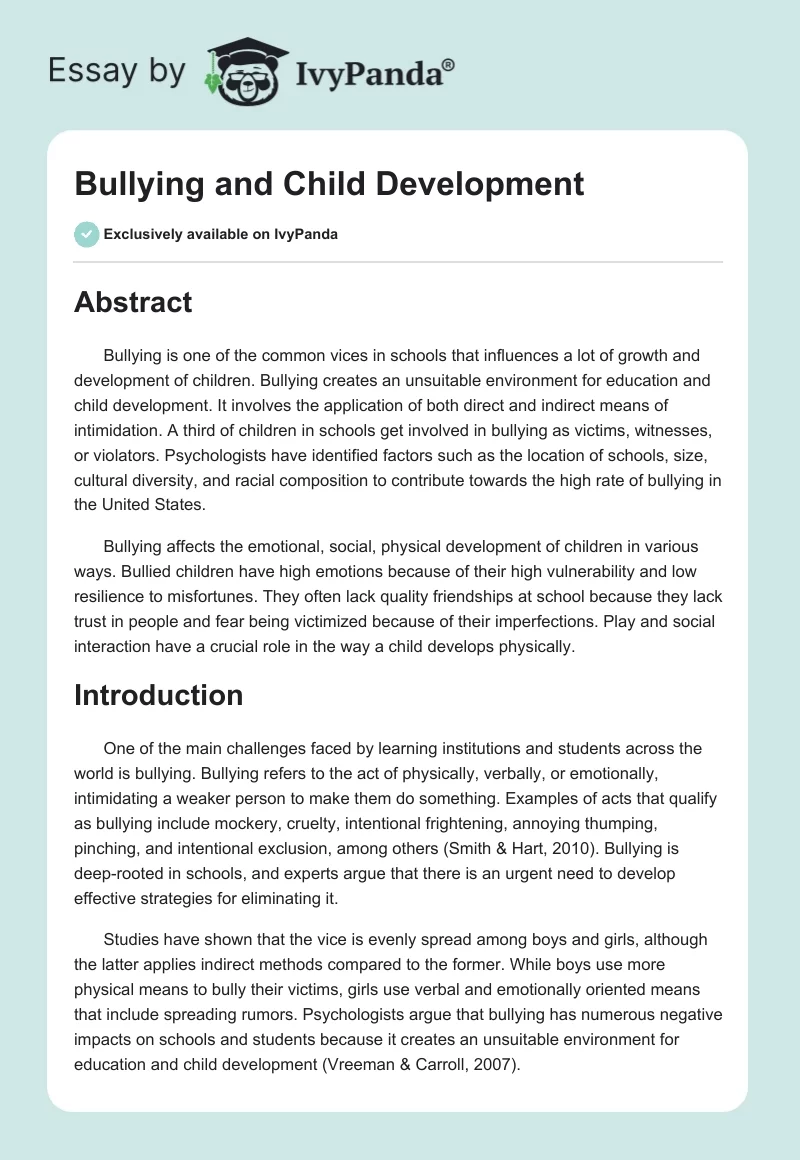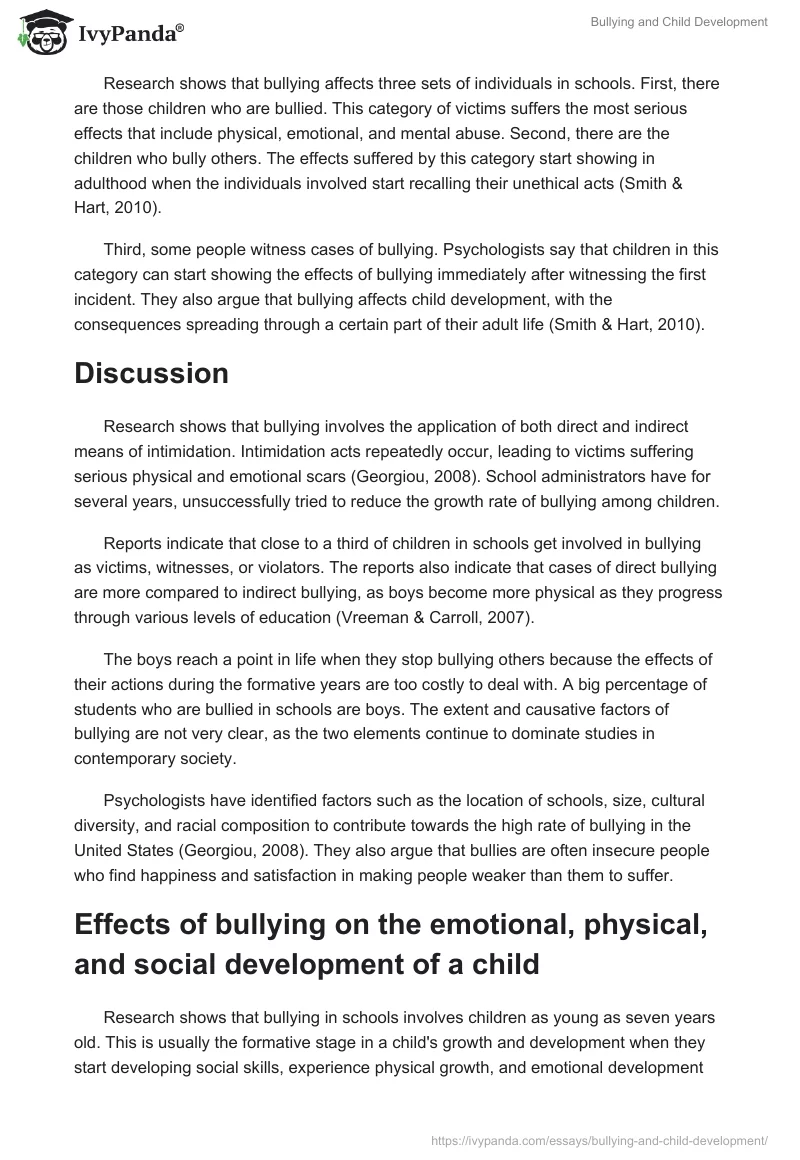Abstract
Bullying is one of the common vices in schools that influences a lot of growth and development of children. Bullying creates an unsuitable environment for education and child development. It involves the application of both direct and indirect means of intimidation. A third of children in schools get involved in bullying as victims, witnesses, or violators. Psychologists have identified factors such as the location of schools, size, cultural diversity, and racial composition to contribute towards the high rate of bullying in the United States.
Bullying affects the emotional, social, physical development of children in various ways. Bullied children have high emotions because of their high vulnerability and low resilience to misfortunes. They often lack quality friendships at school because they lack trust in people and fear being victimized because of their imperfections. Play and social interaction have a crucial role in the way a child develops physically.
Introduction
One of the main challenges faced by learning institutions and students across the world is bullying. Bullying refers to the act of physically, verbally, or emotionally, intimidating a weaker person to make them do something. Examples of acts that qualify as bullying include mockery, cruelty, intentional frightening, annoying thumping, pinching, and intentional exclusion, among others (Smith & Hart, 2010). Bullying is deep-rooted in schools, and experts argue that there is an urgent need to develop effective strategies for eliminating it.
Studies have shown that the vice is evenly spread among boys and girls, although the latter applies indirect methods compared to the former. While boys use more physical means to bully their victims, girls use verbal and emotionally oriented means that include spreading rumors. Psychologists argue that bullying has numerous negative impacts on schools and students because it creates an unsuitable environment for education and child development (Vreeman & Carroll, 2007).
Research shows that bullying affects three sets of individuals in schools. First, there are those children who are bullied. This category of victims suffers the most serious effects that include physical, emotional, and mental abuse. Second, there are the children who bully others. The effects suffered by this category start showing in adulthood when the individuals involved start recalling their unethical acts (Smith & Hart, 2010).
Third, some people witness cases of bullying. Psychologists say that children in this category can start showing the effects of bullying immediately after witnessing the first incident. They also argue that bullying affects child development, with the consequences spreading through a certain part of their adult life (Smith & Hart, 2010).
Discussion
Research shows that bullying involves the application of both direct and indirect means of intimidation. Intimidation acts repeatedly occur, leading to victims suffering serious physical and emotional scars (Georgiou, 2008). School administrators have for several years, unsuccessfully tried to reduce the growth rate of bullying among children.
Reports indicate that close to a third of children in schools get involved in bullying as victims, witnesses, or violators. The reports also indicate that cases of direct bullying are more compared to indirect bullying, as boys become more physical as they progress through various levels of education (Vreeman & Carroll, 2007).
The boys reach a point in life when they stop bullying others because the effects of their actions during the formative years are too costly to deal with. A big percentage of students who are bullied in schools are boys. The extent and causative factors of bullying are not very clear, as the two elements continue to dominate studies in contemporary society.
Psychologists have identified factors such as the location of schools, size, cultural diversity, and racial composition to contribute towards the high rate of bullying in the United States (Georgiou, 2008). They also argue that bullies are often insecure people who find happiness and satisfaction in making people weaker than them to suffer.
Effects of bullying on the emotional, physical, and social development of a child
Research shows that bullying in schools involves children as young as seven years old. This is usually the formative stage in a child’s growth and development when they start developing social skills, experience physical growth, and emotional development (Harris, 2009). Experts argue that one of the most problems that people struggle dealing with is the effects of bullying. The reason for this is that technological advancements have allowed bullies to extend their acts beyond school environments.
In contemporary society, bullying happens over the internet, especially through social media. The group that has the most trouble managing the effects of this vice is children. Children affected by bullying experience difficulties in having normal childhood experiences because of emotional and physical scars (Harris, 2009).
Psychologists argue that bullies often target children who appear weak and different. For example, in the United States, bullies target children based on their ethnic background, social groups, sexual orientation, disabilities, and economic class (Smith & Hart, 2010). Bullying affects the emotional, social, physical development of children in various ways.
Emotionally, bullying affects children by causing stress-related disorders such as anxiety and depression. Children often develop a relatively permanent state of worry and nervousness occurring in a variety of mental disorders (Georgiou, 2008). Anxiety is often accompanied by compulsive behavior or panic attacks. Psychologists say that bullying makes children to experience a vague and unpleasant emotion because they always anticipate a misfortune.
Children also go through a mental state characterized by a pessimistic sense of inadequacy and a despondent lack of activity (Georgiou, 2008). Use of social media makes it hard for children to get a break from bullies because they will extend their acts though social networking sites.
Bullying also affects the ability of children to concentrate in school because they are always on the lookout for the bullies. Children develop emotional issues relating to their safety, with some even contemplating committing suicide (Harris, 2009). These children have high emotions because of their high vulnerability and low resilience to misfortunes.
Bullying also affects social development in children. Social challenges in bullied children have a close relation to the emotional experiences they go through. Bullies instill fear in their victims and make them feel undesirable (Griffiths, Wolke & Harwood, 2006). First, the children lose their connection to school because they have bad memories from their hostile environment. The children begin to withdraw from various social groups for fear of meeting with bullies (Harris, 2009).
Children who are bullied often lack quality friendships at school because they lack trust in people and fear being victimized because of their imperfections. The social challenges can develop out of emotional effects such as depression and anxiety, as the children can feel lonely.
Feelings of loneliness make the children isolate themselves from others and avoid engaging in conflicts because they fear they are likely to feel less accepted by others. Bullying affects the ability of children to acquire and develop social skills because they are always anxious, restless, isolated, and highly suspicious of others (Vreeman & Carroll, 2007).
Psychologists also argue that bullying influences a lot on a child’s physical development. According to experts on child development, play, and social interaction have a crucial role in the way a child develops physically (Smith & Hart, 2010). One of the main effects of bullying on children is the development of conditions such as depression. Depression generally affects the ability of children to have normal physical development because children lose interest in any form of activities.
The lack of interest in physical activity often develops when the bullied children begin to withdraw themselves socially (Griffiths et al., 2006). This means that even opportunities for playing pass them when they are in isolation.
Physical activity plays a crucial role in mental development. It helps to relieve stress and expand the mental capacity of an individual. Children who lose their opportunity to play often end up being depressed and experience a lot of trauma. Children also avoid engaging in physical activities for fear of being targeted by bullies (Griffiths et al., 2006).
Conclusion
Bullying is one of the many school vices that have negative effects on the growth and development of children. This vice affects the ability of children to have normal social, emotional, and physical growth. Bullying involves three categories of individuals, namely the bullies, the victims, and the witnesses. All three categories suffer their unique effects from getting involved in bullying. Some of the common effects of bullying on children include lack of friends due to social withdrawal, depression, anxiety, trauma, and poor academic performance.
References
Georgiou, S. N. (2008). Bullying and victimization at school: The role of mothers. British Journal of Educational Psychology, 78(1), 109-125.
Griffiths, L. J., Wolke, D., & Harwood, J. P. (2006). Obesity and bullying: Different effects for boys and girls. Archives of Disease in Children, 91(1), 121-125.
Harris, M. J. (2009). Bullying, Rejection, & Peer Victimization: A Social Cognitive Neuroscience Perspective. San Francisco: Springer Publishing Company.
Smith, P. K., & Hart, C. H. (2010). The Wiley-Blackwell Handbook of Childhood Social Development. New York: John Wiley & Sons.
Vreeman, R. C., & Carroll, A. E. (2007). A systematic review of school based interventions to prevent bullying. Archives of Pediatrics & Adolescent Medicine, 161(1), 78-88.


